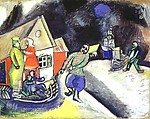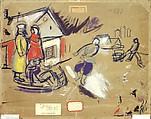Snow, Winter in Vitebsk
Marc Chagall French
Not on view
Born to a Hassidic Jewish family in the provincial capital of Vitebsk in western Russia in 1887, Marc Chagall displayed the talent and vocation of an artist from his early schooldays. In 1907 in St. Petersburg, he studied at the Imperial School of Fine Arts and then privately under Léon Bakst, the Russian painter, illustrator, and stage designer. Chagall himself later became a versatile artist, producing easel paintings, drawings, prints, illustrations for books, stage designs, and stained glass windows. In St. Petersburg, he was exposed to exhibitions of the Fauves (a loose association of painters concerned with brilliant color, rapidly brushed texture, improvised composition, and flattened space) and the Russian avant-garde movement, Mir Iskusstva, which was concerned with a revival of Russian heritage and renewed contact with German, English, and French ideas.
From 1910 to 1914, Chagall lived in Paris where he would later spend most of his expatriate life (1923–41, 1947–85). During these early years, he met members of the avant-garde: the poets Max Jacob and Guillaume Apollinaire, and the painters Amedeo Modigliani, Robert Delaunay, Fernand Léger, and others working in a cubist style. Although Chagall experimented with Fauvism and Cubism, he rejected them in favor of his own unique mode of painting, which blended sentiment and fantasy and often combined events separated by time and space in a single composition. Ultimately, it was his memories of the peasants and the animals in Vitebsk's Jewish ghetto that would serve him with themes for his paintings. Jewish folklore, Old Testament tales, and the circus became his preferred subjects.
Chagall painted Snow, Winter in Vitebsk, about 1911, while he was living in Paris. His memories of Russia fueled his imagination, and thus the series of gouaches he painted during those years are referred to as "Russian recollections." These include several nocturnal views of the suburbs of Vitebsk. Snow—the word is twice inscribed in Cyrillic in the center foreground—is larger than most of the other gouaches in the series. A string of colorful timber houses with high pitched roofs separates the night sky from the snowy plain in which adults pull children on sleds. The cupolas of one of Vitebsk's numerous churches rise at the far right. The luminous colors and naive accents of this image—from the decorated window shutters to the droll, rotund couple evocative of wooden dolls—are elements borrowed from Russian folk art. The figure in the center of the composition, however, seems of a different mettle. Wearing boots, baggy pants, and a patterned blouse, he has about him all the elegance of a dancer from Diaghilev's Ballets Russes, then captivating Paris.
Due to rights restrictions, this image cannot be enlarged, viewed at full screen, or downloaded.
This artwork is meant to be viewed from right to left. Scroll left to view more.



